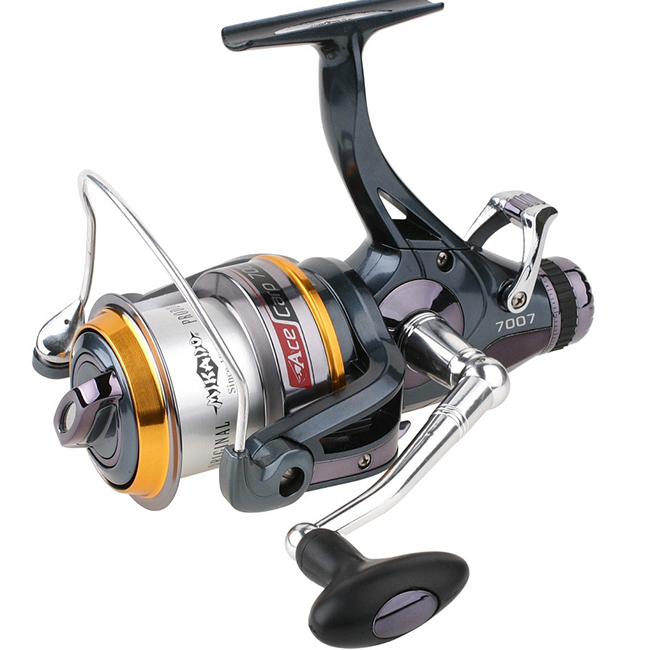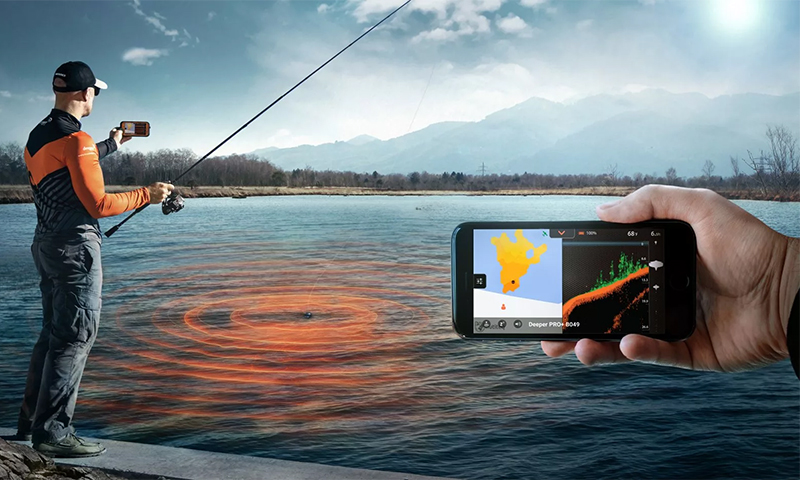A feeder is a type of bottom gear, fishing with its use attracts more and more fishermen. For successful, productive fishing there are no trifles. Therefore, the choice of feeder coil must be approached thoroughly, having studied all the nuances and subtleties.

Content:
The best manufacturers of feeder coils - which company to choose
The best fishing gear, including reels, combining optimal quality parameters and high manufacturability are produced in Japan, products of European manufacturers also enjoy well-deserved popularity.
We recommend to pay attention to the trademark reels:
- Daiwa;
- Shimano;
- Ryobi;
- Mikado;
- Abu Garcia.
Those wishing to understand the intricacies of choosing a feeder coil will help review their varieties, advantages and disadvantages.
The principle of operation and the device coil for feeder

Feeder equip inertia-free coils, also called coils with a fixed spool.
The special feature of the coil is that at the time of throwing, posting and pulling out the fish, the spool does not rotate. Since the spool is stationary, the force of inertia does not affect the casting distance, so the coil is called instantaneous.
The main elements of the coil:
1. Housing;
2. Lever;
3. Spool;
4. Laying machine with roller and staple;
5. Brake adjuster (friction clutch);
6. Rotor;
7. Backward control;
8. Spool lock
The brake adjuster can be located in the front or rear of the coil. For feeder fishing its location does not matter. You can use the coil, which is more familiar and easy to use.
The order of casting when using the inertia-free coil is as follows:
1. Before the throw, the tie wrapper is set aside to freely skip the line;
2. To prevent unwinding of the fishing line, they press it with a finger;
3. At the time of casting the line is released from the clamp;
4. After casting, the brace is returned to its original position and the handle is reeled up onto the reel by turning the handle. In the case of a bite, which is accompanied by a sharp jerk, the brake will work, and the required amount of fishing line will come off the coil.
Types of reel for feeder fishing
Spinning

They are often used to equip the feeder rod. Among the spinning reels, the easiest way is to choose the necessary model, focusing on the gear ratio that is optimal for feeder fishing (4.8: 1, 5.0: 1). Most spinning reels meet bottom fishing requirements.
Benefits:
- Versatility;
- Sufficient power of the coil makes it possible to get a large trophy during fishing;
Disadvantages:
- Feeder fishing creates more severe operating conditions for the spinning reel than those for which it is designed. This shortens its service life;
- Spools of spinning coils have, as a rule, a considerable depth, which implies the use of winding.
Match

This type of spinning reels is the best option for feeder fishing. Match coils are designed for long casting equipment.
For coils of this type is characterized by low-profile geometry of the spool - it is shallow, with a low rim. The necessary capacity of the spool is ensured by its width. As a rule, manufacturers include Match marking in the name of match coils.
Benefits:
- The optimal depth of the spool, allowing the use of a thin fishing line without reeling backing;
- The specific geometry of the spool and low profile facilitate the discharge of the fishing line, while the friction of the fishing line on the side is minimal, which increases the casting distance of the gear;
- Rear friction allows you to effectively change the force on the fishing line when hauling large fish, allows you to quickly replace the spools;
- As a rule, they are equipped with two spare spools, which allows the use of several types of fishing line, adapting to the circumstances of fishing. The spools included in the package of one coil can be of different depths.
Disadvantages:
- Lose power spinning coils, can not be used with heavy feeders;
- Rear friction clutch gives bulkiness;
- The specificity of the geometry of the coil requires extremely high-quality winding, otherwise a thin fishing line or braided cord will form loops and knots when casting.
Carp

Carp coils are the largest, as a rule, the size of the spool from 5000 and more. The main feature of the carp reel is the baytrunner; thanks to this option, even large carp will not pull the rod off the stand during an energetic bite.
The bayrunner is a mechanical system for bleeding the line while the line wrapper is closed, it disengages the friction brake, allowing the line to freely leave the spool. Disconnect the bypass runner manually with a bracket or by turning the coil handle.
Benefits:
- Reliability;
- It makes it possible to loosen the clutch with one movement of the lever and prevent the fishing line from breaking, damage and loss of the fishing rod in case a large fish pulls suddenly;
- It can also signal a poklevka at the time of bleeding off the line, emitting a characteristic crackling sound;
Disadvantages:
- The presence of a baytranner increases the cost of the coil.
Feeder Coil Selection Parameters

Spool (coil) size
Fishing on the feeder implies a long-distance casting of equipment (from 25 to 100 meters). It should be possible to cast the line out of the water quickly enough after casting, so the coil size should be as large as possible. A large reel effectively exhausts the line, it has a fairly powerful mechanism that can withstand heavy loads.
The designation of the size of the coil shows the possibility of a 100 meter line of a certain diameter on the spool. So, on the spool with the designation "2000" 100 meters of fishing line with a diameter of 0.2 mm fit, on the spool "3000" - 100 meters with a diameter of 0.3 mm. For feeders use coils with a size of 3000-4000 (even up to 8000, but not less than 2500).
The number of spools in the configuration
The package of some models of coils can be included several spools. Coils are not all brands and not all types are equipped with two or more spools. Buying a coil, it makes sense to focus on this. This allows you to use a variety of equipment, replacing the spool with a braid on the spool with a monofilny fishing line.
Spool Type
It is preferable to use a shallow spool with a low profile - the lower the line on the reel is laid, the easier it will be to throw.
Low-profile models eliminate the need to prepare a backing for a working line, with its proper installation, the spool side should be no more than 2-3 mm. Otherwise, when casting, the line clings to the profile of the spool, the friction force restrains it, and the rigging will not reach the intended goal.
Spool shape
Since for the most part of the feeder equipment braided fishing line is used, it is preferable to use a spool with a reverse cone. Thanks to this form, while casting, the fishing line will not fly off in whole coils, saving the tackle from tangling.
Gear ratio
The gear ratio is the ratio of one turn of the handle to the number of revolutions of the laying machine around the spool (with precision to decimal). It is indicated on the coil body (for example, 4.0: 1 or 5.6: 1).
According to this parameter, the coils are divided into power and speed. If the first indicator is less than five, the coil refers to the power. For speed relays are coils, which the packer makes more than five turns around the spool in one turn of the handle.
For the feeder, a power coil is required. The best purchase options will be the coil with the indicator of the number of revolutions of the laying machine from 4.6 to 5.2.
Quality of laying fishing line
It is important for reel in feeder fishing. It is better provided by models equipped with a so-called endless screw. If there is a kind of longitudinal bulge on the back of the coil, then it is included in the design. You can also view information about the features of the coil in the technical description.
Coil weight
Comfortable coil weight for a standard rod is 300-350 grams. For a picker rod, which belongs to the lightweight class, the weight of the coil is 240-250 grams. For rods class Heavy (for fishing in rivers with medium and strong over) can be used reel weighing 400-450 grams.
Bearing Quantity
A reel designed for more than one season of use must have four to five bearings or more. An excessively large number of bearings makes the coil heavier, so you should not chase a large number of them.
For feeding gear, it is crucial to have four bearings in the coil:
1. Roller in the laying machine;
2. Two support in the handle;
3. Rotary on the main rod.
Friction clutch
It is necessary for lowering the fishing line from the reel with the active resistance of the fish. Large prey can stretch the line or cut tackle. The friction, tuned to a certain load, "allows" the fish to straighten the line from the reel with strong jerks.
During periods when the prey subsides and ceases to resist, it is tightened, gradually approaching the surface of the water. Without friction, its strength cannot be exhausted. The friction brake may be located at the rear or at the front of the coil. Each type has its pros and cons.
1. Front clutch - adjustable by turning the screw, which also serves as a mount for the spool. It is more convenient to use ultra light gear.
2. Rear clutch - more comfortable when used in more powerful gear designed for larger fish.
3. Baytranner - they equip them with reels designed for catching large fish (most often carp reels have it). Accordingly, their use is advisable on carp rods.
Which coil for the feeder to choose

1. For picer rods and rods of the middle class (medium), coils with a spool size of 2500-3500 will do;
2. For rods of the medium and Heavy class, you can use a reel with a spool size of 4000;
3. For long distance fishing and carp fishing, where the Heavy and Extra Heavy rods are used, reels with a 5000 and 5500 spool are suitable;
4. It is preferable to stop the choice on the coil with a rear friction clutch, the movement of fish with a coil of this design is more convenient;
5. For beginners, feeder catching lovers can be advised to purchase low-priced models of various kinds (for example, match and spinning). This will give an opportunity to get used to it, then choose the most suitable and convenient option for themselves;
6. Beginners should not pay much attention to the number of bearings in the coil, for the development of a new type of fishing enough to purchase a budget coil with four bearings.
How much is the feeder reel

1. The price of a spinning reel is from 0.7 to 42 thousand rubles;
2. The price range for match coils is from 0.35 to 30 thousand rubles;
3. Carp coil with baytranner can be purchased at prices ranging from 1.25 to 26 thousand rubles.
It will be interesting to friends too










